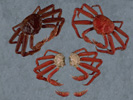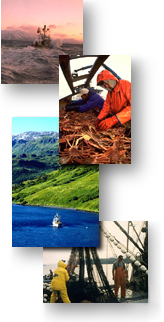|
|
 |
 |
| Snow Crab :: Chionoecetes opilio |
Common names: Snow crab, southern tanner crab (bairdii).
Regional names: Tanner crab, queen crab, spider crab, bairdii crab, opilio
crab.
Identification: Round body with five pairs visible legs. Eyes
either red (bairdii) and green or gray/green (opilio). "M" shaped (bairdii) or
straight teeth (opilio). Hybrid crab (bairdii and opilio) appear where their
ranges overlap in the Bering Sea.
Range: Oregon coast (rare) to Bering Sea, Bristol Bay and
Arctic Ocean to Sea of Japan and Korean Strait.
Season and Catch Methods: January to May in the Bering Sea.
January to March in the Gulf of Alaska. February and March in Southeast Alaska.
Caught in pots or traps.
Size: Bairdii average 2½ lbs, 4 lbs maximum; opilio average 1½
lbs, 2 to 2½ lbs maximum.
Product forms: Fresh: Cooked whole or clusters; legs; meat;
cocktail claws. Frozen: Raw or cooked whole; raw or cooked clusters, legs;
fancy meat; IQF merus meat; cocktail claws. Sections are typically graded:
under 5 oz, 5-8 oz and 8 oz up.
Packaging: Whole cooked crab blast or brine frozen and packed
in 20 to 50 lb cartons. Clusters bulk brine or blast frozen in 25 to 80 lb
baskets and packed in plastic lined boxes. Claws packed in 2 to 5 lb bags in a
20 to 25 lb master carton. Legs (regular and pre-scored) packed in 10 to 25 lb
cartons. Meat (fancy and merus pack) packed in 5 lb blocks.
Nutritional Value (3.5 oz (100 g) raw meat): 90 Kcal, 10.8
Kcal from Fat, 18 g Protein, 1.2 g Total Fat, 0.2 g Saturated Fat, 0.4 g
Omega-3 Fat, 55 mg Cholesterol, 514 mg Sodium.
|
|




